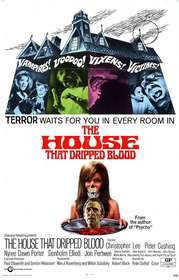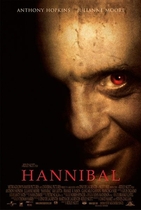Our editor-in-chief Nate Yapp is proud to have contributed to the new book Hidden Horror: A Celebration of 101 Underrated and Overlooked Fright Flicks, edited by Aaron Christensen. Another contributors include Anthony Timpone, B.J. Colangelo, Dave Alexander, Classic-Horror.com's own Robert C. Ring and John W. Bowen. Pick up a copy today from Amazon.com!
The House That Dripped Blood (1971)
From 1965 to 1973, Max J. Rosenberg and Milton Subotsky's Amicus studios unleashed a string of high quality anthology films that were inspired by the macabre morality tales found in the pages of E.C. Comics. It's a format in which the company would excel, as many of these features are now considered classics. One of the studios finest portmanteau efforts is director Peter Duffel's The House That Dripped Blood. The film is extraordinary from start to finish thanks to its exceptional writing, a star-studded cast, and a crew that enlivens what is, for the most part, a stage-bound production.
The story begins as a police inspector is called in to investigate the disappearance of Paul Henderson, an actor who had moved into a house with a history of strange occurrences. From there the film fractures into four tales which are related to the inspector by the homes real estate agent. They go as follows:
"Method For Murder" A writer begins to blur the line between fact and fiction which causes his sanity to be called into question.
"Waxworks" A man becomes obsessed with a caricature in a wax museum that appears to be modeled after a woman he once knew.
"Sweets For The Sweet" A governess is hired to care for a sweet yet reclusive child whose father rules over her in a stern manner. As events unfold, the governess comes to realize that all is not as it seems with the child.
"The Cloak" A veteran horror actor purchases a cloak at a second hand store in order to add realism to his performance and gets more than he bargained for.
Writer Robert Bloch, who is best known as the author of Psycho, provides a screenplay that is aided by contributions from fellow scribes Russ Jones (the "Waxworks" segment) and Richard Matheson ("Sweets For The Sweet")1. Together these three writers conjure up four tales that are well rounded thanks to solid set-ups, well developed characters, and spine tingling climaxes. The film's wraparound story is also of interest and ties in with the final segment to perfection, allowing the film to end on a chilling high note.
Bloch had become a regular writer for Amicus by the time that The House That Dripped Blood was released in 1970, having previously penned three standard films (The Skull, The Psychopath, and The Deadly Bees) as well as the anthology styled feature Torture Garden. The varying storylines on display within these pictures further cements the fact that Bloch's talents went far beyond his most famous work (Psycho).
Although the film was made for the general public, the more serious horror fan will have a blast with the film's story lines as they supply several subtle (and not so subtle) winks to the genre. Within these four tales are several visual references to dark literature (such as The Complete Stories and Poems of Edgar Allan Poe, and Montague Summers' The Vampire: His Kith and Kin), mention of the Universal films Frankenstein, The Phantom of the Opera, and Dracula, as well as narratives revolving around genre artists such as actors and writers. The fourth installment ("The Cloak") is of particular interest to fans as it shows the behind the scenes details of making a low budget feature. These delicate nods to the film's perceived audience are done with tongue planted firmly in cheek which adds a touch of wit and humor to a picture that was otherwise designed to frighten.
Of course the storytelling would mean next to nothing if it weren't for the tremendous cast that is on hand for The House That Dripped Blood. Like all of the Amicus anthologies the film is a veritable who's who of the genre with Christopher Lee, Peter Cushing, Denholm Elliott, Jon Pertwee, Joss Ackland, and Ingrid Pitt all getting a chance to show off their acting chops.
Although each of these thespians give it their all, providing spectacular performances throughout, it's Pertwee's performance as Paul Henderson that steals the show. Henderson is an aging, arrogant movie star and Pertwee dives head first into the role, creating the character's persona of arrogance through mannerisms, tone of voice, and body language. For example, when Henderson arrives on the set of the current film he is working on, he agrees with the art director's set design in model form. However, when he sees the constructed full size scenery, his overall mood dampens. Pertwee's face turns dour, and his tone of voice condescending, as he refers to the set design as being "so flimsy you could blow peas through it". He does this as he is poking holes in a freshly painted castle wall with his cane in a violent manner. He then tells a member of the wardrobe department that they can use a part of his costume for draperies before stomping off to his dressing room, slamming the door in the face of the writer who is trying to give him a copy of the shooting script. Pertwee maintains a consistent facial expression (that of utter disgust) throughout all of this while also using a sarcastic vocal tone. It's Pertwee's ability to portray his characters underlying cynicism that enables his performance to become the film's acting highlight.
Like many of Amicus's films The House That Dripped Blood has a professional sheen that can be credited to a talented group of artisans behind the scenes. One of these unsung craftsmen, art director Tony Curtis, was vital when it came to defining the look of an Amicus feature and would lend his skills to several of the company's features such as And Now The Screaming Starts, I, Monster, and Madhouse to name but a few. Curtis does an excellent job of making the film's many stage-bound sets, which were shot at the legendary Shepperton studios, seem realistic. Whether he's rearranging items within the titular house to blend with the correlating episode, crafting the menacing look of a wax museum for the "Waxworks" segment, or overseeing the design of fake sets for the movie within the movie episode "The Cloak", the film has an organic feel that never succumbs to the stuffy confines of the stage.
Cinematographer Ray Parslow is the perfect compliment to Curtis's exceptional talents for staging as he proves to be rather adept behind the camera. Throughout the film Parslow displays a keen eye for differing camera angles, lenses, and techniques all while doing a splendid job with the lighting. Take the hallucination sequence during the "Waxworks" segment for example. During this sequence Parslow employs rack focusing, zooms, and fish eyed lenses to create a dizzying visual effect while setting an unnatural tone with sharp red, blue, and green lights. This combination of elements captures the scenes intended nightmarish qualities and is but a small sample of Parslow's skill set. By the picture's conclusion, it seems as if he has exhausted every popular visual trick available at the time with sound results.
The film emits a continual sense of menace that can be attributed, somewhat, to the discordant score provided by Michael Dress. By using strings, organs, and deep percussion, Dress fills the picture with eerie passages that subtly creep in, pricking at the viewers nerves. This can be evidenced during a simple scene in the "Method For Murder" segment. As the killer (Dominic) approaches Joanna Dunham's character (Alice )the drums and piano pound away with every footstep while a steady minor note is held in the background. This intensifies as Dominic gets closer to Alice and when she turns to see his reflection in a mirror, the sounds crash together in a nerve shattering crescendo meant to maximize the heightened tension of the scene.
The Amicus anthologies of the late 1960s - early 1970s are often considered the crowning achievements of the now-legendary British studio's output. Although all of these features are entertaining, there are a select few that manage to work the format to perfection and Peter Duffel's The House That Dripped Blood is one such picture. The film provides enough thrills, chills, and E.C.-styled karmic comeuppance to establish it as one of the company's best portmanteau efforts.
1 Topping, Keith. A Vault of Horror: A Book of 80 Great (and Not so Great) British Horror Movies from 1956-1974. Tolworth: Telos Pub, 2004. Print.









This is a well-written
This is a well-written review, but also an extremely generous one.
While I enjoyed the movie, my description of it would lean more towards terms like hokey, corny, twee and quaint. This is almost entirely down to the script, which I felt was considerably below the standard of the acting and production it received. The final scene delivered to camera I found so risible as to be craptastic.
When I cite the acting, I exclude the performance of Jon Pertwee; Bruce, you singled it out as the best perfomance in the film, where I would say it was a gurning OTT embarrassment that considerably lowered the tone of the whole thing. As for Jon "creating the character's persona of arrogance through mannerisms, tone of voice, and body language", I respectfully suggest that Jon was merely playing himself.
On the other hand, I quite liked Geoffrey "Catweazle" Bayldon fanging the scenery in his cameo. Go figure.
You're on the money when you drop a reference to EC Comics. The House is a fun movie, but in my opinion, impossible to take seriously.